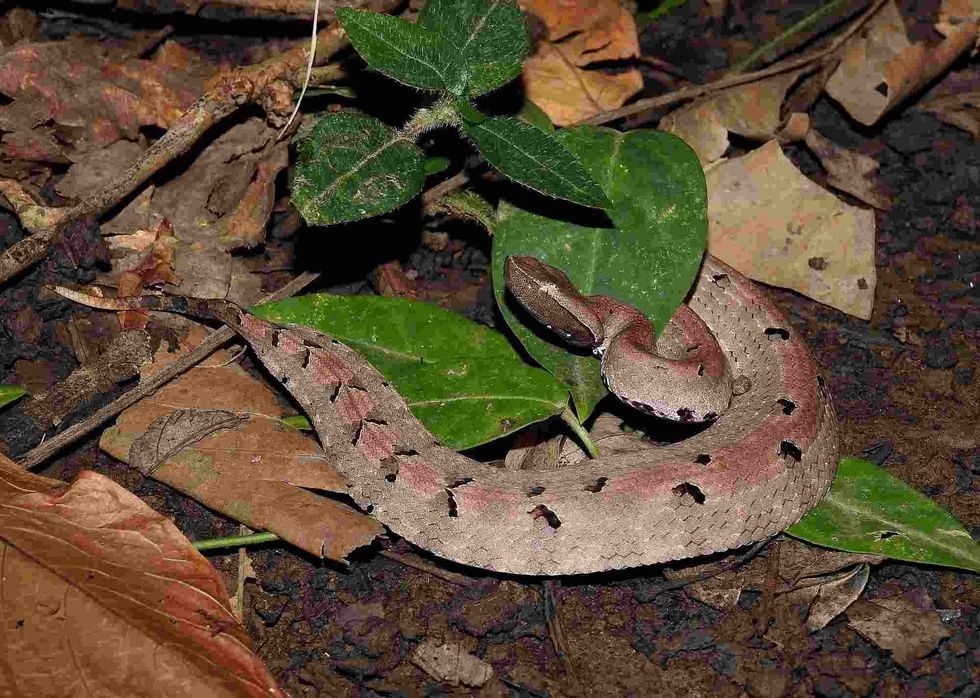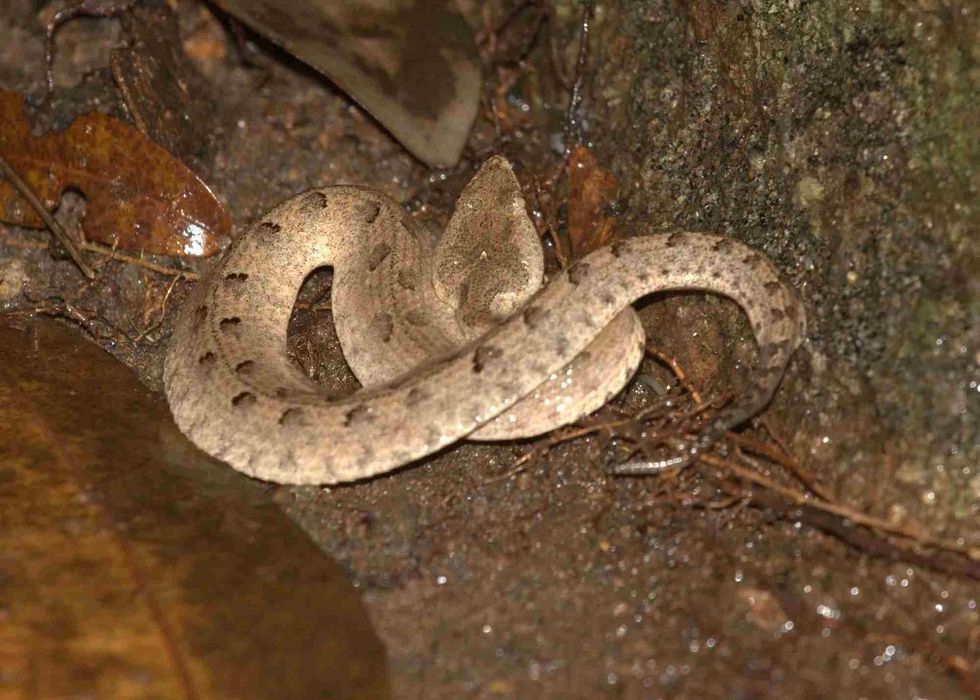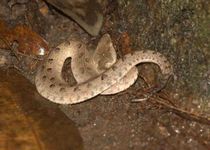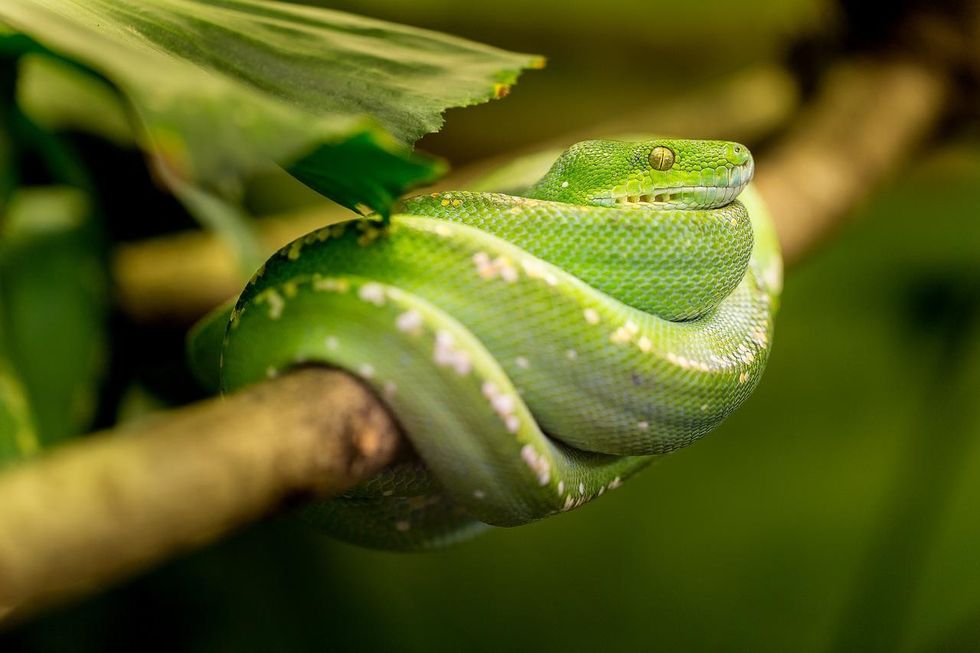Fun Hump-nosed Pit Viper Facts For Kids

Are you looking for some awesome snakes endemic to the Indian subcontinent? Then you must read about the hump-nosed pit viper.
Belonging to the Hypnale genus, which contains two more closely related species, the hump-nosed pit viper, Hypnale hypnale, is quite an interesting viper to learn about. They are generally found in the forests and mountains of southern and western India, as well as being distributed throughout Sri Lanka.
Want to learn more about the effects of the Hypnale hypnale's venom and other facts? Scroll down to take a look. You can also take a look at Himalayan pit vipers and saw-scaled vipers.
Hump-Nosed Pit Viper Interesting Facts
What type of animal is a hump-nosed pit viper?
The hump-nosed pit viper (Hypnale hypnale) is a species of pit vipers snakes that are endemic to the Indian and Sri Lankan regions. The species has gained prominence in recent years due to an increase in the number of snake bite deaths caused by it.
Most interestingly, standard antivenom doses that work for well many other snake bites, do not really have much effect for a hump-nosed pit viper bite.
What class of animal does a hump-nosed pit viper belong to?
Hump-nosed pit vipers belong to the class of Reptilia or reptiles. These pit vipers from India and Sri Lanka belong to the genus Hypnale and the family Viperidae.
Now, before they underwent a review, these snakes from India and Sri Lanka, were part of the Agkistrodon genus of pit vipers. Pit vipers of the Agkistrodon genus are often referred to as the American moccasins. However, recent research has put these poisonous snakes in a different category altogether, the genus Hypnale.
Hypnale is a genus of vipers that contains three species all within the countries of Sri Lanka and India. The three different species are the hump-nosed pit viper (Hypnale hypnale) from India and Sri Lanka, the Sri Lankan hump-nosed viper (Hypnale nepa), and Gray's hump-nosed viper (Hypnale zara) from the country of Sri Lanka.
In regards to their scientific name, this hump-nosed viper has a host of different synonyms like Hypnale affinis, Ancistrodon hypnale, and Ancistrodon millardi.
How many hump-nosed pit vipers are there in the world?
Unfortunately, the information regarding the total population of hump-nosed pit vipers (Hypnale hypnale) is not available. As such, this species hasn't been evaluated by conservation organizations like the International Union For Conservation Of Nature and as a result, data regarding their total population is difficult to come across.
However, the lack of data regarding the population of H. hypnale doesn't mean that the snakes are under significant threat. On the contrary, there are quite common in their native range of India and Sri Lanka.
Where does a hump-nosed pit viper live?
The hump-nosed pit viper (Hypnale hypnale) is a kind of viper that can be found in dense and moist forests, plantations, and montane forests. As has already been mentioned quite some time in this article, this hump-nosed viper is distributed throughout the southern and western parts of India and in some areas of Sri Lanka.
In the Western Ghats of India, which is a continuous low altitude mountain range, H. hypnale is found till the 16 degrees north latitude. The Indian states included within this range are Goa, Karnataka, and Kerala.
Sometimes, they can also be found in the state of Tamil Nadu. They are most prevalent in a place called Castle Rock in Karnataka.
As for Sri Lanka, they are distributed throughout the country. They are often spotted in places such as the Makandawa Forest Reserve, Sinharaja Forest Reserve, the Knuckles Conservation Forest, and the Ritigala Strict Nature Reserve.
What is a Hump-Nosed Pit Viper's habitat?
This species of hump-nosed viper can be found in montane forests, coffee plantations, and moist, dense foliage. Generally, these snakes usually hide in leaf litter and bushes in a coiled-up manner and are quite good at camouflaging themselves.
Being primarily terrestrial snakes, they are active during the night and the early hours of the morning, making them nocturnal creatures. In their habitat range, these snakes are often found basking in the sunlight during dawn by the banks of streams and rivers.
Not surprisingly, these snakes have been known to have a temper only when irritated. In a behavior that is similar to rattlesnakes, they often vibrate their tail to show their annoyance.
When irritated, this viper bites the person or the animal causing disturbances. You may be shocked to hear that a hump-nosed viper bite was earlier thought to be not that dangerous.
Who do hump-nosed pit vipers live with?
Like most snakes, H. hypnale snakes are solitary creatures who go about minding their own business. The males and the females of this snake species only get together when they want to copulate during the breeding season. Otherwise, this snake from India and Sri Lanka is mostly seen to be alone.
How long does a hump-nosed pit viper live?
Even though there has been updated information regarding the hump-nosed viper snake venom, the lifespan of the species is still an elusive mystery. Generally, pit vipers have the tendency to live for around 12 -24 years.
We can assume that the longevity of the venomous hump-nosed pit viper is somewhere in that range in their native habitats in Sri Lanka and India.
How do they reproduce?
The reproduction of the hump-nosed viper is viviparous in nature. This means that the female snake will give birth to a live young snake.
This is an exception for the pit viper snake family because most snakes in this family are ovoviviparous, i.e. ; they give birth to eggs that hatch inside their body to produce their offspring.
While the egg-bearing pit vipers are fiercely protective of their eggs, we cannot really confirm whether the H. hypnale display similar behavior when guarding their young.
For these snakes, the breeding period is thought to be between the months of March and July, which signifies that these snakes breed primarily during the summer months in the Indian subcontinent.
Again, we do not know much about the courtship rituals within the species and can only presume that they have certain auditory, olfactory, or sensory cues through which they communicate with the opposite gender during the mating time.
There are conflicting reports on the total number of offspring produced by Hypnale hypnale, with some sources claiming that the litter size ranges from 4-10, while others quoting the litter size to be around 4-17 young snakes.
What is their conservation status?
Major conservation organizations like the International Union For Conservation of Nature haven't evaluated the venom-carrying hump-nosed vipers.
Thus, we do not really know about their conservation status within their current habitat range. However, one of the other species from the Hypnale genus has been evaluated by the IUCN in the Red List.
The Hypnale nepa from Sri Lanka has a Least Concern classification in the IUCN Red List, and with no major threats affecting the Hypnale hypnale, it is safe for us to assume that this species doesn't require much conservation.
Hump-Nosed Pit Viper Fun Facts
What do hump-nosed pit vipers look like?

The appearance of the hump-nosed vipers is similar across the three species in their genus. H. hypnale are medium-sized snakes whose body coloration can vary from individual to individual. Showing the typical build of vipers with stout bodies and wide heads, these snakes can range from grayish to dark-brown with regards to their color pattern.
Interestingly, large dark marks or blotches cover their body. There can also be a whitish line running down from their heads. The undersides of these snakes are dark or yellowish as well.
You can know you have found this species from its unique humped snout. This special snout turns upwards, coming to an end in a snout.
The head is sort of triangular, with quite big scales on it. The frontal and supraocular scales are large as well. However, the size of the scales decreases when we examine them on the snout, where they are formed in an irregular pattern.
Like all pit vipers, the hump-nosed variant has sensors between their eyes and nostrils. These sensors, located in pits, help the snakes to understand changes in temperatures in their surrounding, giving them a sort of sixth sense which aids them in hunting.
How cute are they?
While many wildlife enthusiasts might marvel at the beauty of the scales of Hypnale hypnale, the species may not be cute to many people due to their bites. Now, of course, you wouldn't find them cute and adorable when the viper bites you.
How do they communicate?
They have two sensory pits located between their eyes and nostrils. This allows the Hypnale hypnale to seek out warm-blooded prey near them.
How big is a hump-nosed pit viper?
Despite growing up to a size of around 12-18 in (30-46 cm) with a maximum reported length of 24 in (60 cm), Hypnale hypnale snakes are considered to be some of the smallest in the pit viper family. The Indian cobra grows up to more than three to four times their size.
How fast can a hump-nosed pit viper move?
Although they are slow-moving creatures, a hump-nosed viper bite can occur quite fast. This viper bites in a flash and can inject fatal venom when they are attacked or irritated.
How much does a hump-nosed pit viper weigh?
The weight of Hypnale hypnale has not been estimated yet.
What are the male and female names of the species?
Like all snakes, males and females have no sex-specific names.
What would you call a baby hump-nosed pit viper?
A baby of this species could be simply called a snakelet.
What do they eat?
Being carnivorous creatures, H. hypnale preys on smaller animals and mammals like lizards, skinks, and frogs.
Are they poisonous?
Of course, these snakes have venom. In fact, this venom has the ability to cause fatality when not treated for some time.
Earlier, a hump-nosed viper bite was thought to be harmless. Yet, now many snakebite incidents in India and Sri Lanka have been attributed to this species.
When this viper bites, their venom has the ability to cause capillary leak syndrome, where fluids and proteins flow out of blood vessels, resulting in a decrease of the blood plasma level and very low blood pressure.
In general, pit viper venom can kill someone within half a day if not treated promptly.
Would they make a good pet?
No, absolutely not. These venomous snakes are best suited to the wild.
Did you know...
Standard antivenom that works for the bites of the big four species of venomous snakes in India (Indian cobras, Russell's vipers, Indian kraits, saw-scaled vipers), do not have any effect on hump-nosed pit viper bites. As such, the antivenom may cause adverse allergic reactions if administered after a bite.
This is due to the fact that while the other snakes were studied, this particular pit viper was left understudied, resulting in no proper antivenom being developed.
However, recent steps have been taken to solve the antivenom problem. The Clodomiro Picado Institute in Costa Rica has taken up the responsibility to develop an antivenom for trial in Sri Lanka.
The venom of the Hypnale hypnale is also medically important and can be studied to make blood thinners that stop the blood from clotting.
What is special about a pit viper?
The most special things about pit vipers are the two heat-sensitive pits between their eyes and nostrils and the movable fangs that some genera in their family have.
What is the difference between a viper and a pit viper?
Vipers, in general, do not have heat-sensitive pits which their close relatives from the pit viper family have.
Here at Kidadl, we have carefully created lots of interesting family-friendly animal facts for everyone to discover! Learn more about some other reptiles from our glossy snake facts and mud snake facts pages.
You can even occupy yourself at home by coloring in one of our free printable viper coloring pages.
Main image by Gihan Jayaweera.
Second image by Dr. Raju Kasambe.
We Want Your Photos!
More for You
Bachelor of Arts specializing in Journalism and Mass Communication, Postgraduate Diploma in Sports Management

Moumita DuttaBachelor of Arts specializing in Journalism and Mass Communication, Postgraduate Diploma in Sports Management
A content writer and editor with a passion for sports, Moumita has honed her skills in producing compelling match reports and stories about sporting heroes. She holds a degree in Journalism and Mass Communication from the Indian Institute of Social Welfare and Business Management, Calcutta University, alongside a postgraduate diploma in Sports Management.
Bachelor of Arts specializing in Economics

Gowri RaoBachelor of Arts specializing in Economics
With a bachelor's degree in Economics from Krea University, Gowri is a highly skilled data analyst and an expert in regression and causation modeling. Her interests in economic trends, finance, and investment research complement her professional expertise. In addition to her professional pursuits, Gowri enjoys swimming, running, and playing the drums, and she is also a talented tutor.
Disclaimer
1) Kidadl is independent and to make our service free to you the reader we are supported by advertising. We hope you love our recommendations for products and services! What we suggest is selected independently by the Kidadl team. If you purchase using the Buy Now button we may earn a small commission. This does not influence our choices. Prices are correct and items are available at the time the article was published but we cannot guarantee that on the time of reading. Please note that Kidadl is a participant in the Amazon Services LLC Associates Program, an affiliate advertising program designed to provide a means for sites to earn advertising fees by advertising and linking to Amazon. We also link to other websites, but are not responsible for their content.
2) At Kidadl, we strive to recommend the very best activities and events. We will always aim to give you accurate information at the date of publication - however, information does change, so it’s important you do your own research, double-check and make the decision that is right for your family. We recognise that not all activities and ideas are appropriate for all children and families or in all circumstances. Our recommended activities are based on age but these are a guide. We recommend that these ideas are used as inspiration, that ideas are undertaken with appropriate adult supervision, and that each adult uses their own discretion and knowledge of their children to consider the safety and suitability. Kidadl cannot accept liability for the execution of these ideas, and parental supervision is advised at all times, as safety is paramount. Anyone using the information provided by Kidadl does so at their own risk and we can not accept liability if things go wrong.
3) Because we are an educational resource, we have quotes and facts about a range of historical and modern figures. We do not endorse the actions of or rhetoric of all the people included in these collections, but we think they are important for growing minds to learn about under the guidance of parents or guardians.







